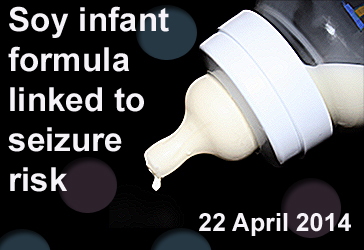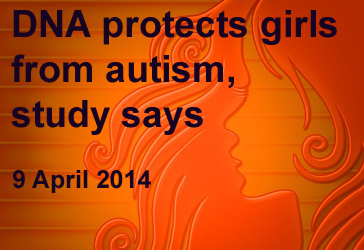Archives
April, 2014
Select a different month in the archive
Soy-Based Infant Formula Doubles Risk of Seizures
By Shana R. Spindler, Ph.D. on April 22, 2014

Background: Nearly 25 percent of infant formulas use soy protein, and many families rely on this non-dairy alternative during an infant’s first years of life. Some are concerned, however, that a component in soy called phytoestrogens may have an adverse impact on infants’ health by mimicking hormones in the body. Given the widespread use of soy-based formula, relatively few studies have addressed the effect of phytoestrogens on early childhood development.
What’s new: In 2013, Dr. Cara J. Westmark of the University of Wisconsin, Madison, reported that mice with neurological disease had more seizures while eating a soy-based diet. Now, she has expanded her studies to a human population. In the March 2014 issue of the online journal Plos One, Dr. Westmark reports that children with Autism Spectrum Disorder (ASD) are 2.6 times more likely to have febrile seizures—those associated with a high fever—and 2.1 times more likely to have epilepsy when given a soy-based infant formula. Even though the study was large, including 1,949 children, caution should be taken before making firm conclusions. The formula and seizure data were based on parental recall, and the study did not take into account the reasons for using soy formula nor the length of time on it.
Why it’s important: This study highlights the need to further investigate an association between phytoestrogen exposure early in life and an increased risk of seizures in the ASD population. The ability to decrease seizure risk through diet modification alone would be an important finding for those with ASD.
Help me understand :
| Source(s) : |
| Tweet |
Are Females Protected Against Autism by Their DNA?
By Eric Larsen, Ph.D. on April 9, 2014

Background: One of the hallmarks of Autism Spectrum Disorder (ASD) is its increased prevalence in males, with an estimated male-to-female ratio of four-to-one. Scientists hypothesize that this gender bias may be the result of the “female protective model.” According to this model, a greater extent of genetic damage is required to overcome an inherent protective mechanism in females. Subsequently, ASD is found more often in males, who require less genetic damage to trigger ASD onset.
What’s new: A recent report in the American Journal of Human Genetics analyzes the genetic variation present in male and female individuals with ASD. The authors report that females with ASD possess a greater number of damaging genetic variants compared to males on the spectrum. Moreover, damaging genetic variations are inherited more often from mothers, rather than fathers. Given that males and females have a different set of sex chromosomes (females have two X chromosomes, and males have an X an Y chromosome), the authors questioned if genetic changes to the X chromosome might put males at higher risk for ASD. They concluded, however, that genetic variation in the X chromosome made very little contribution to ASD.
Why it’s important: This study strengthens the case for a “female protective model” in ASD. Future research will likely seek to understand the underlying basis for this protective effect in females. Furthermore, the findings of this study may have potential implications in the interpretation of genetic screening studies in ASD cases.
Help me understand :
| Source(s) : |
| Tweet |

